Unlike many in the Charleston area who were only able to see a pumpkin-colored smudge in the cloudy sky instead of the blood supermoon, contributor Kyra Morris of Mount Pleasant was able to see it clearly in New Mexico, where she was traveling. She sent along the photo used in her monthly column below. Thanks for the view, Kyra!
IN THIS ISSUEPHOTO: Blood supermoon, courtesy of New Mexico
FOCUS, John Tecklenburg: Will put residents’ quality of life first as mayor
BRACK: State’s tax structure needs work, not praise
IN THE SPOTLIGHT: SCIWAY
MORRIS: Blood supermoon: Astronomical phenomenon or apocalypse?
GOOD NEWS: Cannon Street Y All-Stars to be honored
FEEDBACK: On Stavrinakis candidacy, Haley’s posturing
CALENDAR, Sept. 28+: Festivals all over the place
MYSTERY: Where is this old bridge?
S.C. ENCYCLOPEDIA: Loggerhead turtles
TODAY’S FOCUS
Will put residents’ quality of life first as mayor
By John Tecklenburg, candidate for mayor of Charleston
SEPT. 28, 2015 | My comprehensive plan for Charleston, Our Quality of Life First, is not what anyone would call a slickly-packaged public relations document.
In fact, if you head over to our website and take a quick look at it, the first thing you’ll probably notice is that it’s light on pretty pictures and heavy on specifics. But that’s not the only way it differs from some other plans you may have seen.
First, this plan is achievable. It is 16 pages of practical, bullet-point proposals to address some of the most fundamental challenges facing Charleston today — from managing growth and development, to making tourism work better for our citizens, to giving our residents and neighborhoods a greater say in their own future.
Second, it’s not a cut-and-paste, pie-in-the-sky wish list of programs that our city can neither implement nor afford.
Instead, it outlines a concrete series of steps that we can take together as a community to make Charleston not just the number one place in the world to visit, but also the number one place to live and work and raise a family.
As I said, this plan is different. And there’s a reason for that.
As many of you probably know, I’ve never run for political office. My experience is primarily in the area of making things work — as the founder of Southern Oil Company, as the president of civic organizations like Crisis Ministries and the SC Strong, and as the director of economic development for the city of Charleston.
The biggest lesson I’ve taken from those experiences is that a clearly-defined goal, like making Charleston number one in livability for our residents, is just the first step.
After that, you need a real way of getting there. My comprehensive plan offers five major components:
- Livability and Quality of Life, starting with a strong focus on public safety, greater citizen and neighborhood involvement in city planning, flooding relief, new cruise ship regulations, a pause in new hotel rooms in the city center, and a top-to-bottom zoning review to protect our neighborhoods from out-of-control growth and sprawl.
- Transportation and Public Transit, including completion of I-526, a rethink of major arteries like Folly Road, Savannah Highway and Sam Rittenberg Boulevard, a regional and practical solution to public transit, preferred parking for local residents, and making our city more walkable and bikeable with light infrastructure improvements, better signage and a major north-south bike corridor on the peninsula.
- Economy and Jobs, featuring a comprehensive approach to job creation and economic development — one that protects our quality of life, while focusing on knowledge-based jobs, education and training, affordable housing and strategic economic development in areas like West Ashley and the upper peninsula.
 Better City Services, requiring real accountability measures like performance audits and rigorous statistical assessments, modern technologies like 311 and smartphone apps, and the deployment of citizens service representatives to all five major areas of the city.
Better City Services, requiring real accountability measures like performance audits and rigorous statistical assessments, modern technologies like 311 and smartphone apps, and the deployment of citizens service representatives to all five major areas of the city.- Stronger Neighborhoods, including a number of specific initiatives to empower and improve every area and neighborhood in Charleston — West Ashley, Johns Island, James Island, Daniel Island and the peninsula.
For almost 40 years now, Joe Riley has charted a bold course for our city, one that has made us all proud, even if we occasionally differed on some of the details.
I believe the course that I’ve laid out in my plan, while different, is every bit as bold, and focuses on what a mayor can do with community support.
First, we consolidate the remarkable gains of the last four decades, recognizing that Charleston has now become a great American city for tourism, commerce and industry. And then, working together, we make sure that it’s also the best city in America to call home.
That’s the goal. And it would be the greatest honor of my life if you gave me the opportunity to work with you to make that goal become a reality for everyone in Charleston.
John Tecklenburg, a candidate for mayor of Charleston, is a businessman, civic leader and former city government executive. Learn more about his campaign here: tecklenburgformayor.com
EDITOR’S NOTE: Charleston Currents has offered this space to each of the Charleston mayoral candidates to share their views with readers. Today’s installment wraps up the series. Click the “2015 Election” tab at top to see pieces by William Dudley Gregorie, Maurice Washington, Toby Smith and Leon Stavrinakis, Ginny Deerin and John Tecklenburg.
COMMENTARYState’s tax structure needs work, not praise
By Andy Brack, editor and publisher
SEPT. 28, 2015 | The sad thing about a new study of state tax systems is that people are going to believe it when, in fact, it is pretty misleading and relatively pointless.
![]() WalletHub, a website that offers consumer information and tools geared toward personal finance, frequently runs rating studies on everything from credit card debt to financial literacy for states. But some of their work gets a little squishy with studies like on best- and worst-run cities, school systems and active lifestyle communities or reports on happy states and the most and least energy-efficient states.
WalletHub, a website that offers consumer information and tools geared toward personal finance, frequently runs rating studies on everything from credit card debt to financial literacy for states. But some of their work gets a little squishy with studies like on best- and worst-run cities, school systems and active lifestyle communities or reports on happy states and the most and least energy-efficient states.
Now in focus is the new offering that highlights the most and least fair state tax systems. According to WalletHub, South Carolina has the third fairest tax system in the country behind Montana and Oregon. But dig into the study’s methodology and you realize quickly that it relies on what people think a fair tax system should be, not whether it is empirically fair according to economic principles. To make these opinions look more scientific, WalletHub’s exercise in confusion then compares people’s thoughts about what they should pay in taxes to actual tax burden data.
The gaping hole in this logic is as big as the Grand Canyon: Who really believes they should pay more taxes than less? As the late U.S. Sen. Russell Long of Louisiana once noted, “Don’t tax you. Don’t tax me. Tax that fellow behind the tree.”
Simply put, the flawed WalletHub study doesn’t rely on basic economic tax fairness principles like equity (ability of people to pay), adequacy (whether the system raises enough money for people’s needs), neutrality, transparency and simplicity. In fact, noted Clemson economist Holley Ulbrich poked lots of holes in this publicity stunt in just a few minutes.
“It’s pretty simplistic,” she said, noting that opinions on fairness have a high degree of subjectivity. “It doesn’t consider the distribution of the tax burden in other ways, most notably between renters and homeowners since Act 388” which swapped property tax revenue for more regressive sales tax revenue.
Ulbrich listed four indicators of unfairness in South Carolina’s current tax system, which generates $7 billion a year in general fund revenues. (The state also pulls in another $8 billion in federal funds plus $9.3 billion in “other funds,” such as college tuition, health reimbursements, sales taxes for education, lottery proceeds, car license fees and cigarette taxes.)
- Adequacy: “It doesn’t provide enough revenue to adequately fund education (K-12 and secondary), roads, prisons and DSS, all of which matter to all our citizens.”
- Equity: “It puts too much of the burden on commercial and rental property and favors homeowners.”
- Balance: “It relies too heavily on the sales tax, which is more of a burden on the poor, made worse by our very limited taxation of services, which would make it less regressive.”
- Preference: “It especially favors retirees over working people with generous income tax exemptions for pensions and Social Security.” For example, South Carolina exempts $56,000 from all income from tax for everyone. Seniors, however, can get up to $63,000 more in income tax breaks.
 Despite continuing inequities identified in a much-ignored 2010 report by a blue-ribbon state panel of tax experts, South Carolina has a relatively competitive income tax, according to figures gleaned from the S.C. General Assembly. Since 2006, the General Assembly takes credit for reducing income taxes for individuals and small businesses by $1.6 billion. And the state’s income tax is generally much lower than in neighboring Georgia and North Carolina thanks to substantially lower effective (or real-world) tax rates. Overall, South Carolina has one of the lowest tax burdens — amount of taxes people actually pay — in the nation, according to reputable organizations like the Tax Foundation.
Despite continuing inequities identified in a much-ignored 2010 report by a blue-ribbon state panel of tax experts, South Carolina has a relatively competitive income tax, according to figures gleaned from the S.C. General Assembly. Since 2006, the General Assembly takes credit for reducing income taxes for individuals and small businesses by $1.6 billion. And the state’s income tax is generally much lower than in neighboring Georgia and North Carolina thanks to substantially lower effective (or real-world) tax rates. Overall, South Carolina has one of the lowest tax burdens — amount of taxes people actually pay — in the nation, according to reputable organizations like the Tax Foundation.
Bottom line: Politicians are likely to showcase WalletHub study to highlight how they don’t need to do anything (sound familiar?) to fix the state’s tax structure.
Hooey. Don’t be fooled. Rather than having the “third fairest” tax structure, South Carolina’s system is riddled with billions of dollars of sales tax exemptions and an income tax structure that can use some more work from the bottom up, not top down.
Andy Brack is editor and publisher of Charleston Currents and Statehouse Report. You can reach him at: editor@charlestoncurrents.com
IN THE SPOTLIGHTSCIWAY
 The public spiritedness of our underwriters allows us to bring Charleston Currents to you at no cost. Today we shine our spotlight on SCIWAY. Pronounced “sky-way,” SCIWAY is South Carolina’s Information Superhighway — the largest and most comprehensive directory of South Carolina information on the Internet. It includes thousands of links to other South Carolina Web sites, including Charleston Currents, as well as an amazing collection of maps, charts, articles, photos and other resources.
The public spiritedness of our underwriters allows us to bring Charleston Currents to you at no cost. Today we shine our spotlight on SCIWAY. Pronounced “sky-way,” SCIWAY is South Carolina’s Information Superhighway — the largest and most comprehensive directory of South Carolina information on the Internet. It includes thousands of links to other South Carolina Web sites, including Charleston Currents, as well as an amazing collection of maps, charts, articles, photos and other resources.
- To learn more about this extraordinary information hub that 7 million people visit a year, go to: http://www.SCIWAY.com.
The blood supermoon: Astronomical phenomenon or apocalypse?
By Kyra Morris, contributing editor
SEPT. 28, 2015 | As USA Today put it, “It almost sounds like something from a comic strip: A total supermoon lunar eclipse, also known as a blood moon — supermoon.” This is real, and by the time you read this, it happened in its fullness on Sunday, Sept. 27, 2015, lasting until early Monday morning.
 Why is this worth writing about? Well, this particular phenomenon seldom happens. The last time was 1982 and the next time will be in 2033. It was also visible during prime time. You did not have to wait until 3 in the morning to catch a glimpse.
Why is this worth writing about? Well, this particular phenomenon seldom happens. The last time was 1982 and the next time will be in 2033. It was also visible during prime time. You did not have to wait until 3 in the morning to catch a glimpse.
The blood moon is a confluence of three things. First, there is a full moon. Second, the full moon happens to be at the closest point in its orbit around the Earth. This is called a supermoon because it is 14 percent larger and 33 percent brighter than other full moons. Third, there is a lunar eclipse. This is when the Earth lines up directly between the sun and the moon, and the moon is completely in the shadow of the Earth. The debris and light reflections from the Earth’s atmosphere reflect a reddish color on the moon. Therefore, it’s been called the blood moon.
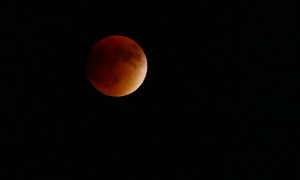 Wait – there’s more. There are a lot of speculations that the combined supermoon and lunar eclipse is a recipe for world disaster – an apocalypse . This particular supermoon-blood moon is said to be the last of a “tetrad,” four consecutive total lunar eclipses, each separated by six lunar months, that took place on Jewish holidays. The first three in the current series took place April 15, 2014; Oct. 8, 2014; and April 4, 2015. There is also a link between the tetrad and key years in history, such as 1492, the expulsion of Jews from Spain; 1948, the birth of Israel; and 1967, the Six-Day War. Each tetrad year appears to have significance. I’ve only mentioned a few.
Wait – there’s more. There are a lot of speculations that the combined supermoon and lunar eclipse is a recipe for world disaster – an apocalypse . This particular supermoon-blood moon is said to be the last of a “tetrad,” four consecutive total lunar eclipses, each separated by six lunar months, that took place on Jewish holidays. The first three in the current series took place April 15, 2014; Oct. 8, 2014; and April 4, 2015. There is also a link between the tetrad and key years in history, such as 1492, the expulsion of Jews from Spain; 1948, the birth of Israel; and 1967, the Six-Day War. Each tetrad year appears to have significance. I’ve only mentioned a few.
We have been watching the skies for thousands of years, creating mythology and connecting the Earth to the universe with our legends and stories. The coincidence with Jewish holidays and the tetrad is logical, since the Jewish calendar is a lunar calendar. Then there are the significant historical years. Yet this could possibly be an example of confirmation bias. Confirmation bias occurs when we look for connections that fit pre-conceived notions.
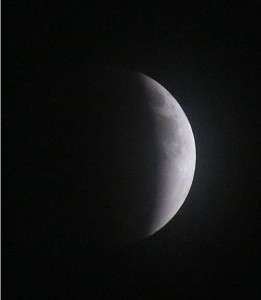
Contributing photographer Michael Kaynard snapped this local shot of the moon as the eclipse progressed — and before the clouds covered up everything.
This is an alignment of the Earth, sun and moon that happens to occur when the moon is at the closest point in its orbit. For those with clear skies and possibly binoculars it was a gorgeous sight – an historical event since it happens so infrequently. Remember the last one was in 1982 and the next one won’t be until 2033. Is it a message from God? I happen to believe so. Is it a message of imminent pending disaster? I am not convinced.
The message I get is that we – the Earth and the Earth’s inhabitants – are connected to the universe. The universe is powerful, spectacular, and majestic. I interpreted from this event that we have a responsibility. Our responsibility is to be mindful of our precious Earth. Each of us in our own way need to do what is within our power to act in harmony with our surroundings, our community, and our mother planet. Maybe I am too simplistic, but I take it as a very strong message.
I am not saying that things are hunky-dory in the world today. We have economic stagnancy in Europe. We have a slowdown in economic growth in China, and a volatile stock market. These things aren’t going away overnight. I am saying that the correlation with these things and the blood moon-supermoon is simply a dramatic conjecture. I bet if I did the research I could create my own confirmation bias that links the blood moon-supermoon to historically good things. So, first, I hope you were able to see the blood moon-supermoon and revel in the majesty of our universe. And then I want to wish upon you many blessings and good things in the weeks/years to come.
Kyra Hollowell Morris, a Certified Financial Planner, is CEO of Morris Financial Concepts, Inc., in Mount Pleasant. A national leader in the financial planning profession, she has been named several times by leading magazines as one of the country’s top financial planners.
GOOD NEWSAll-Stars to be honored as “barrier breakers”
Members of Charleston’s 1955 Cannon Street Y All-Star team will be honored Oct. 7 as “Barrier Breakers” by the National Consortium for Academics and Sports at its annual banquet and Hall of Fame induction.

Earlier this summer, members of the 1955 Cannon Street All-Star team were honored at the Little League World Series in Williamsport, Pa. Pictured, l-r: Team historian Agustus Holt, John Bailey, David Middleton, John Rivers and Allen Jackson. Photo provided.
In the summer of 1955, a team of 14 African-American boys form the Cannon Street YMCA Little League entered a local tournament to try to get to win a trip to the Little League World Series in Pennsylvania. South Carolina had 61 other teams, all of which had white players. None of the white teams would play the Cannon Street team, which led to them being named winner at state and regional levels by default. When they reached the national tournament, they weren’t allowed to play, however, due to rules.
“At the time, those 14 young boys probably had no idea the impact they had on society,” according to the NCAS in a release about the award. “They inspired people then and continue to even today.”
John Rivers, a former player who is now a Georgia architect, reflected, “In 1955 we just wanted to play ball, and we weren’t allowed to do so. Since then, we have realized that we and our coaches and parents were taking a bold stand in the midst of the civil rights movement that was transforming our country. We had to sacrifice in 1955, as millions of other people also sacrificed at the time. The result was the overturning of prejudicial laws in all spheres of life. As this summer’s shooting in Charleston has shown, there is much racism and hatred that still must be overturned. We must still show strength, as we did in 1955. But we’ve made unbelievable gains, and we are all determined to make even more.”
In more good news:
Charleston native confirmed to head federal agency. The U.S. Senate on Tuesday night confirmed President Obama’s nomination of Charleston native Kathryn K. Matthew to be director of the Institute of Museum and Library Services, an independent federal agency that is the primary source of federal support for the nation’s 123,000 libraries and 35,000 museums.
“I am honored to have been nominated by President Barack Obama and to have received the confidence from the Senate through their confirmation process. I look forward to being appointed to serve as the fifth Director of the Institute of Museum and Library Services,” said Matthew, still a Charleston resident. She is married to George Stevens, past head of the Coastal Community Foundation.
Matthew will serve a four-year term as the director of the Institute. Trained as a scientist, Matthew has had a 30-year museum career and worked in the private sector. She received a bachelor’s degree from Mount Holyoke College, master’s in business administration from the University of Minnesota’s Carlson School of Management, and a Ph.D. from the University of Pennsylvania. More.
Justice seminar: State. Sen. Marlon Kimpson, D-Charleston, and Charleston County Sheriff Al Cannon will lead a 6 p.m. Oct. 8 forum titled “21st Century Social Justice.” The event, which will be held the ILA Hall, 1142 Morrison Drive, in Charleston, is open to the public and features a former federal prosecutor and an expert on criminal sentencing. For more details, contact: fortysixblue@gmail.com
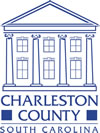 Reassessment notices on the way. More than 185,000 reassessment notices for real property and mobile homes have been sent by Charleston County to ensure property owners understand the periodic tax reassessment required by law. Because property values change over time, reassessment equalizes the tax burden so that every property owner pays taxes in proportion to the value of the property as of the most recent reassessment.
Reassessment notices on the way. More than 185,000 reassessment notices for real property and mobile homes have been sent by Charleston County to ensure property owners understand the periodic tax reassessment required by law. Because property values change over time, reassessment equalizes the tax burden so that every property owner pays taxes in proportion to the value of the property as of the most recent reassessment.
The last reassessment in Charleston County was implemented in 2011. At reassessment, state law limits the increase in the taxable value on most properties to a maximum of 15 percent over the prior value. The 15 percent cap is a cap on the increase in value, not on taxes. Taxes are influenced by many other factors such as millage, exemptions, deductions and special use values. Bottom line: Even if your reassessment goes up or down, you could pay less in taxes based on the rate set by the county.
The Charleston County Assessor’s Office staff includes licensed and certified appraisers who perform ongoing research into the local real estate market. At reassessment, real property is valued based on that research. The market for property creates the value, and the market is driven by buyers and sellers. Therefore, supply and demand is the largest single factor in determining a property’s value.
If someone disagrees with the value on their reassessment notice, they have the right to file an objection in writing to the Charleston County Assessor’s Office within 90 days from the date on the reassessment notice. A form for filing objections will be included with the reassessment notice to make it easy for owners. More: Phone a hotline with questions — (843) 958-4144 — or check the county’s website.
FEEDBACKWants Columbia attitudes to stay in Columbia
To the editor:
![]() Reading of the lofty political promises of Mr. Stavrinakis [9/14: In race to move Charleston forward, keep it together], I have to ask, do we need to inject the politics and attitudes of the South Carolina General Assembly into our City Hall?
Reading of the lofty political promises of Mr. Stavrinakis [9/14: In race to move Charleston forward, keep it together], I have to ask, do we need to inject the politics and attitudes of the South Carolina General Assembly into our City Hall?
This would include such an attitude as, it’s OK to put your brother on the MUSC Board of Trustees, or it’s OK to merge MUSC and the College of Charleston into one big school.
I say , leave Columbia in Columbia.
— Ben Moise, Charleston, S.C.
Haley will get a backache from so much posturing
To the editor:
I found your article [Brack, Haley’s ambition puts DHEC between rock, hard place] to be amazingly accurate and a reflection of my own thoughts about our governor.
The only issue you didn’t mention was how she will end up with a backache after all that political posturing. I find it incredible that our Republican legislators can think (or just say) that by cutting funds for our contraceptive services they will reduce the number of abortions. How is that rational? I would love for there to be no need for our abortion services, but that is unrealistic. I would love for our law makers to do something so that we will no longer be number one in men killing women, but that is what our legislators are doing when they try to deny safe, legal medical procedures for the women of our state.
I came to South Carolina when abortion was legal but generally unavailable. One of the first patients I encountered in our small community hospital was a 25-year-old black woman who presented with severe abdominal pain and a high fever. After evaluation, I ended up doing exploratory abdominal surgery and found that her three-and-one-half month pregnant uterus had been perforated by a rubber tube that had been inserted by a back alley abortionist. She (I still remember her name) ended up with a complete hysterectomy and, after a month in the hospital, a complete recovery from the almost fatal infection.
Do we really want to go back there? I, for one, don’t. Thanks again for adding a small voice of reason in the face of the crazies. (I didn’t say that.)
– Name withheld upon request
Send us a letter. Rant. Rave. Tell us what you really think. If you have an opinion on something we’ve offered or on a subject related to the Lowcountry, please send your letters of 150 words or less to: editor@charlestoncurrents.com. Our feedback policy.
CALENDARSept. 28+: Greek Festival, Thanks Joe rally, Latin American Festival
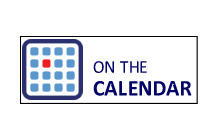 Charleston Greek Fall Festival: Oct. 2-4, Greek Orthodox Church of the Holy Trinity, 30 Race St., Charleston. Join a celebration of Greek faith, culture, food, wine and music at this annual tradition. Free for active-duty military and kids under 13. Just $3 for seniors and students; $5 for adults. More.
Charleston Greek Fall Festival: Oct. 2-4, Greek Orthodox Church of the Holy Trinity, 30 Race St., Charleston. Join a celebration of Greek faith, culture, food, wine and music at this annual tradition. Free for active-duty military and kids under 13. Just $3 for seniors and students; $5 for adults. More.
PURE Theatre show: Through Oct. 2, 477 King Street, Charleston. The theatre will offer the southeastern regional premier of Gina Gionfriddo’s critically-acclaimed comedy, “Rapture, Blister, Burn,” at 3 p.m. or 7:30 p.m. (check the website for more details).
Thanks Joe! 3 p.m. to 7 p.m., Oct. 4, at Brittlebank Park, followed by 7 p.m. to 9 p.m. at nearby Joe Riley Stadium, Charleston. This is a privately-funded, family event to allow people to give their appreciation for Mayor Joe Riley’s 40 years of public service. The first half of the event will feature games and food, while the last two hours will include a Blue Dogs all-star tribute, rocker Edwin McCain, the Emanuel AME Choir and more. More details to come.
Latin American Festival: 11 a.m. to 6 p.m., Oct. 4, Wannamaker County Park, North Charleston. The 24th edition of the festival will feature sensational sounds and vibrant performances from seven acts, including a 12-piece salsa band and urban group from Miami. Dance, art, food and children’s activities are also available at the event, which has an entry fee of $10 per person, with discounts to children, college students, seniors and military. More: CharlestonCountyParks.com
(NEW) Middle East talk: 6 p.m., Oct. 7, Citadel Alumni Center, 69 Hagood Ave., Charleston. The World Affairs Council of Charleston will host a talk by Paul Hughes, senior advisor for international security and peacebuilding at the U.S. Institute of Peace. Learn more.
That BIG Book Sale: Oct. 9-11, Omar Shrine Auditorium, 176 Patriots Point Road, Mount Pleasant. The Charleston Friends of the Library will host the 34th annual sale with more than 60,000 books, DVDs, CDs, music and maps for prices that start at 50 cents. Great bargains are to be had. Admission is free. Hours are more are here: www.charlestonlibraryfriends.org
(NEW) Star War Reads Day: 11 a.m. to 2 p.m., Oct. 10, Main Library, Calhoun Street, Charleston. The Charleston County Public Library will host an afternoon of Star Wars-related fun for the family. Photos with popular characters, costume contest, music and more. More.
Autumn on the Ashley: 9 a.m. to 5 p.m., Oct. 10-11, Magnolia Plantation and Gardens, S.C. Highway 61, Charleston. The popular attraction will have more than 50 vendors exhibiting wood carvings, paintings, textiles, pottery, jewelry and more at the 8th annual event. More.
Polo: 11:45 a.m. to 6 p.m., Oct. 11, Sandcastle Community Center, 1 Shipwatch Road, Kiawah Island, S.C. The Kiawah Cares Foundation will host the inaugural Kiawah Cup Beach Polo invitational on the beach as a new fundraiser. To learn more about tickets, which now are on sale, go to: KiawahCup.org
(NEW) North Charleston Block Party: 4 p.m. to 8 p.m., Oct. 17, Olde Village, East Montague Street near Park Circle. This third annual event will feature live music, arts and craft booths, costume contest and more. There will be trick-or-treating for kids 12 and under. Email for more information.
(NEW) History of Charleston’s mayor: 6 p.m., Oct. 28, Main Library, Calhoun Street, Charleston. Just in time for the 2015 election, the library will host a talk that delves into the evolution of Charleston’s executive office, from “intendant” to mayor. More.
Bird walks: 8:30 a.m. to noon, every Wednesday and Saturday. This is the time of year that a great variety of migrating birds fly through the Lowcountry so what better time to take part in one of the regular early morning bird walks at Caw Caw Interpretive Center in Ravenel. Pre-registration is suggested. Cost is $5. Walks also are conducted on James Island and Folly Beach. Learn more online.
If you have an event to list on our calendar, please send it to editor@charlestoncurrents.com for consideration. The calendar is updated weekly on Mondays.
REVIEWThe Poacher’s Son
A mystery by Mike Bowditch
 The Poacher’s Son, the first in Edgar Award nominee Paul Doiron’s Mike Bowditch series, is set in the beautiful, vast, and treacherous wilderness of Maine. Doiron crafts a tortured, complex hero in Bowditch. Bowditch, a Maine game warden, struggles to prove his father’s innocence in the murder of a police officer, yet is haunted by his father’s past transgressions and inadequacies as a father. Bowditch’s investigation is inhibited by his colleagues’ disdain for his family, and by his own doubts in his father’s fiber.
The Poacher’s Son, the first in Edgar Award nominee Paul Doiron’s Mike Bowditch series, is set in the beautiful, vast, and treacherous wilderness of Maine. Doiron crafts a tortured, complex hero in Bowditch. Bowditch, a Maine game warden, struggles to prove his father’s innocence in the murder of a police officer, yet is haunted by his father’s past transgressions and inadequacies as a father. Bowditch’s investigation is inhibited by his colleagues’ disdain for his family, and by his own doubts in his father’s fiber.
Well-crafted and superior in depth to the cookie cutter mysteries of today’s most prolific writers, Doiron creates complexity in character and paints a vivid setting that leaves the reader craving the next installment. Fans of C.J. Box will find an intriguingly complex and troubled alternative to Box’s Warden Joe Pickett in Mike Bowditch.
— Cary Jones, Main Library, Charleston, S.C.
![]() Find this and similar titles from Charleston County Public Library. This item available as a book. To learn more or place a hold, visit www.ccpl.org or call 843-805-6930.
Find this and similar titles from Charleston County Public Library. This item available as a book. To learn more or place a hold, visit www.ccpl.org or call 843-805-6930.
Where is this old bridge?
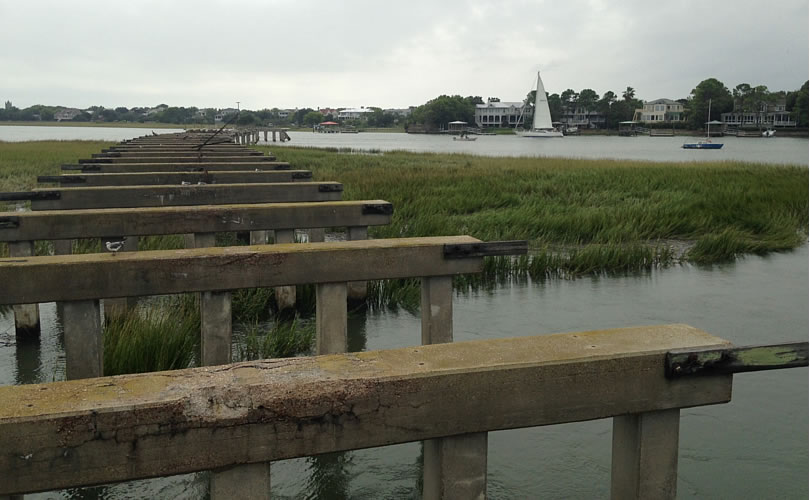 Mount Pleasant reader Deborah Getter sent along this photo, which certainly stumped us. Tell us where it is and its historical significance and you’ll win the endearing love and affection of hundreds of people. (Hint: It’s in Charleston County.) Send your guess — and town you live in — to editor@charlestoncurrents.com.
Mount Pleasant reader Deborah Getter sent along this photo, which certainly stumped us. Tell us where it is and its historical significance and you’ll win the endearing love and affection of hundreds of people. (Hint: It’s in Charleston County.) Send your guess — and town you live in — to editor@charlestoncurrents.com.
 Two people correctly identified Fred Sales’ tough Mystery Photo in our last issue as the front gate at Bethel United Methodist Church on Pitt Street in downtown Charleston. Hats off to Becky Frederick of Mount Pleasant and Katrina Wheeler of West Ashley. And many thanks to others throughout Charleston and on Isle of Palms who tried.
Two people correctly identified Fred Sales’ tough Mystery Photo in our last issue as the front gate at Bethel United Methodist Church on Pitt Street in downtown Charleston. Hats off to Becky Frederick of Mount Pleasant and Katrina Wheeler of West Ashley. And many thanks to others throughout Charleston and on Isle of Palms who tried.
- If you have a picture with which you’d like to stump our readers, send it along to editor@charlestoncurrents.com.
Loggerhead turtle
S.C. Encyclopedia | The loggerhead turtle (Caretta caretta), a threatened species, was named the state reptile in an act signed by Governor Carroll Campbell on June 1, 1988. Recognizing the loggerhead as “an important part of the marine ecosystem” and that South Carolina’s coastline provides “some of the most pristine nesting areas” for the turtle on the East Coast, the General Assembly declared that the state’s responsibility is “to preserve and protect our wildlife and natural resources.”
 The loggerhead is one of the world’s eight living species of sea turtles and evolved some sixty-five million to seventy million years ago. At birth, hatchlings are about two inches long. Adults can weigh from 200 to 350 pounds, and their carapace, or upper shell, measures from thirty-three to forty inches in length. The animal is yellow and reddish brown and has a distinctive large head—the source of its name—with powerful jaws enabling it to crush clams, crustaceans, and other food. Its great size and hard shell protect the adult turtle from most predators.
The loggerhead is one of the world’s eight living species of sea turtles and evolved some sixty-five million to seventy million years ago. At birth, hatchlings are about two inches long. Adults can weigh from 200 to 350 pounds, and their carapace, or upper shell, measures from thirty-three to forty inches in length. The animal is yellow and reddish brown and has a distinctive large head—the source of its name—with powerful jaws enabling it to crush clams, crustaceans, and other food. Its great size and hard shell protect the adult turtle from most predators.
Adult loggerheads in the western Atlantic range from Newfoundland to Argentina, but they nest in the temperate zones. Breeding occurs in the ocean, and females lay their eggs between May and September. South Carolina beaches are favorite nesting grounds. The female comes ashore at night, lays from eighty to two hundred eggs in her nest, then returns to sea. Eggs and hatchlings are prey to many predators, from ants and crabs to dogs, raccoons, birds, and fish in the sea. Hatchlings must head directly to the ocean, and it is estimated that only one in ten thousand loggerhead eggs makes it to maturity. Dangers to the baby turtles include artificial lights on land, for they may head toward those, instead of seaward, and fall victim to predators. It is believed that it requires twelve to thirty years for loggerheads to reach maturity.
Adult loggerheads are imperiled by collisions with boats and, especially, by being trapped in commercial fishing and shrimping trawl nets, in which they drown if they cannot escape. South Carolinians have been active in working to protect nests and hatchlings, and communities have enacted restrictions on coastal lighting during nesting season. State legislation requires turtle excluder devices (TEDs) on trawl nets in order to protect the species.
– Excerpted from the entry by David C.R. Heisser. To read more about this or 2,000 other entries about South Carolina, check out The South Carolina Encyclopedia by USC Press. (Information used by permission.)
About Charleston CurrentsOUR UNDERWRITERS
Charleston Currents is an underwriter-supported weekly online journal of good news about the Charleston area and Lowcountry of South Carolina.
- Meet our underwriters
- To learn more about how your organization or business can benefit, click here to contact us. Or give us a holler on the phone at: 843.670.3996.
OUR TEAM
Charleston Currents offers insightful community comment and good news on events each week. It cuts through the information clutter to offer the best of what’s happening locally.
- Mailing address: P.O. Box. 22261 | Charleston, SC 29413
- Phone: 843.670.3996
Charleston Currents is provided to you twice a week by:
- Editor and publisher: Andy Brack, 843.670.3996
- Contributing photographer: Michael Kaynard
- Contributing editor, real estate: Doug Holmes
- Contributing editors, seniors: Catherine LaFond, Mary Ross McQuage
- Contributing editor, money: Kyra Morris
- Contributing editor, Palmetto Poem: Marjory Wentworth
SUBSCRIBE FOR FREE
Subscriptions to Charleston Currents are free.
Click here to subscribe.


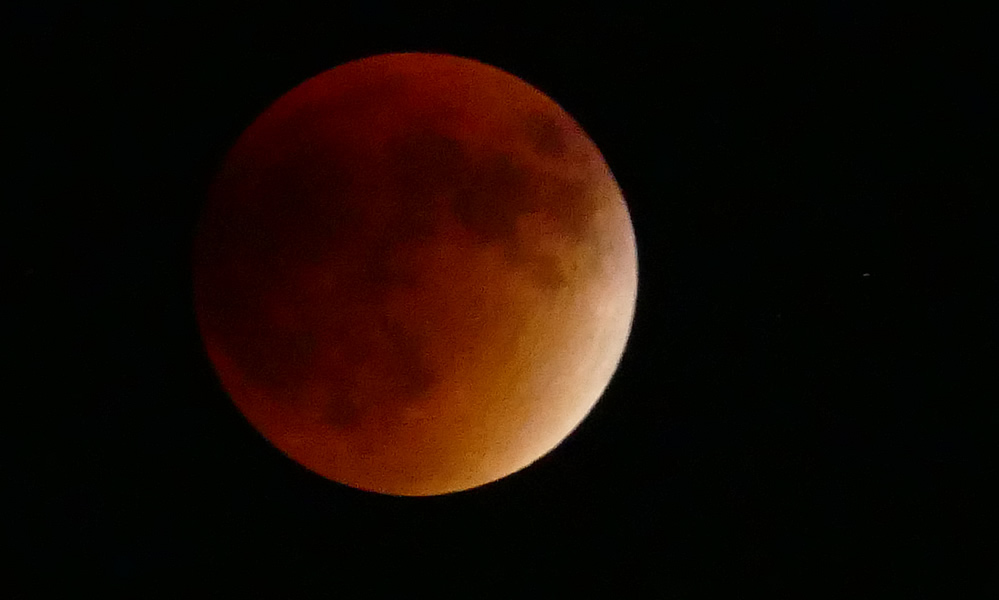

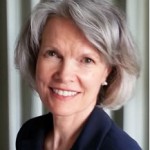

 We Can Do Better, South Carolina!
We Can Do Better, South Carolina!
























